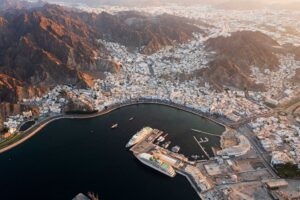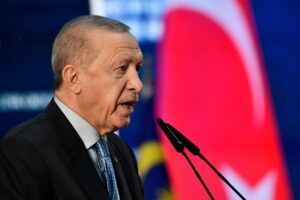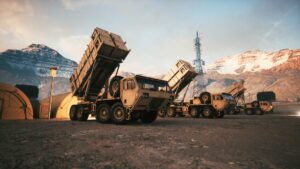China’s status as a leading power in the Middle East is a mixed one. Over the past two decades its presence and influence has grown as it has become a major regional trading and investment partner. Yet its regional rise has not entailed a parallel expansion as a military power or security provider, with China largely avoiding direct confrontation with the region’s leading power, the United States.
That is one way to view China in the Middle East. But it is also a narrow interpretation of leadership. Leadership is associated with power and when that is viewed more broadly, then China’s potential as a regional leader becomes clearer.
Power can be understood in several ways. The version many are most familiar with is the “narrowest”, coercive or compulsory kind: where one actor, A, compels another, B, to do something.[1] But this is merely the most direct kind of power. There are also indirect ways to exercise influence. Agenda-setting or institutional power entails A providing a range of options from which B can choose.[2] Examples of this might be international organisations such as the World Bank and the International Monetary Fund, which favour economically liberal measures such as markets, free trade and private property rights and offer funds to countries in exchange for implementing such measures.
More diffuse than coercive or institutional power is structural power.[3] Here the preferences and behaviour of A and B are shaped by developments beyond their direct control or involvement. An example of this in today’s world is captured by the power of capitalism, in which one group – the “haves” – dominate the access and use of resources over another – the “have nots”. Capital’s power cuts across national borders and is dominant in the constituent parts which make up the international system, in state elites and those who run international organisations.
Finally, productive power entails the emergence and development of new discourses, which may lead to alternative values, norms and frameworks.[4] Examples of this include the rise and promotion of human rights and democracy, while others have become discredited and withered, like territorial imperialism.
In terms of coercive or compulsory power, it occupies a secondary position to the U.S.
So, how has China performed in relation to these forms of power in the Middle East? In terms of coercive or compulsory power, it occupies a secondary position to the U.S. Moreover, it has largely pulled its punches and avoided confrontation with it. Its decision to act in this way has not weakened it; on the contrary, it has strengthened and advanced its interests.
A good example of this was in Iraq. Despite opposing the U.S. invasion in 2003, China benefited from the subsequent American occupation. While the U.S. struggled to establish security in the country, Chinese firms took advantage of the new commercial opportunities and contracts in the oil sector that were on offer and which were often at the expense of American firms.[5] Those connections have expanded without any involvement in the country’s security; a development that led U.S. President Barack Obama to criticise Chinese “free riding”.[6]
Chinese unwillingness to become involved in security affairs has arguably helped it spread its economic interests across the region, despite regional antagonisms. It has signed comprehensive strategic partnerships with those countries it deems most important – Saudi Arabia, the United Arab Emirates, Egypt and Iran – along with a comprehensive innovation partnership with Israel.[7] These agreements are the highest form of interaction that China offers, short of an alliance. They involve co-operation and development across a wide range of areas short of any political or security involvement.[8] Even when it has participated in military exercises, as it did with Iran at the end of 2019, it sought to downplay their influence, stressing their connection to anti-piracy operations and peacekeeping purposes.[9]
China’s ties to its partners involve trade and investments in non-hydrocarbon energy development as well as in financial services, manufacturing, healthcare and real estate.
The extensive nature of these partnerships shows how far Chinese regional interests have developed. They are not limited to imports of oil and gas, since China has sought to diversify its supplies in recent years.[10] Instead, China’s ties to its partners involve trade and investments in non-hydrocarbon energy development as well as in financial services, manufacturing, healthcare and real estate. Moreover, although the terms of trade are weighted more towards China, the financial exchanges between China and the Gulf states like the U.A.E., Saudi Arabia and Qatar are becoming more complex and go both ways, involving both substantial Chinese investments in the Gulf and Gulf investments in China.[11]
China’s commercial advances and security-related limits in the region have prompted it to adopt a hedging strategy where it balances and engages with all regional powers and their rivalries.[12] It has pursued this approach even as the U.S. under President Donald Trump has sought to turn the Middle East into a theatre of great power contestation with China. Last year the U.S. pressed Israel to resist Chinese investment, especially in sensitive areas like its 5G telecommunications network and in the refurbishment and management of its ports, where the American navy occasionally docks.[13] More recently, similar pressure has taken place in Egypt and the U.A.E.[14]
U.S. pressure on its allies and against its rivals like Iran and Syria has prompted the latter to play up their ties with China and show that they are not as diplomatically isolated as they appear.[15] Despite their claims of close friendship with China though, reciprocal Chinese statements and actions have been less fulsome. For example, during summer 2020 a Sino-Iranian deal worth $400 billion in investments surfaced. While analysts questioned both the sums and the Iranian economy’s capacity to absorb such an amount, Chinese officials’ relative silence was less noted.[16] Similarly, despite President Bashar al-Assad’s invitation for Chinese firms to help Syria’s postwar reconstruction, actual Chinese investment has been relatively modest; the most generous estimates are around $2 billion since 2017.[17]
Even if actual Chinese activity and leadership lags behind that of the U.S., that does not mean it will always remain so.
Yet, even if actual Chinese activity and leadership lags behind that of the U.S., that does not mean it will always remain so. By using other forms of power, there may arise a possibility of China playing a more significant Chinese role in the region . That prospect is largely associated with its Belt and Road Initiative (BRI), whose regional progress suggests changes in the institutional and productive character of power in the region.
The BRI was launched in 2013, a year after President Xi Jinping came to power. Although its initial focus was to increase connectivity in China’s immediate neighbourhood of Southeast and Central Asia through physical infrastructure and communications projects, it has since come to cover the whole Eurasian landmass.[18] That has opened up the Middle East as a site for potential collaboration.
Institutionally, a number of entities have either been set up or are being reconfigured to enable China to advance the goals and features of the BRI in the region. One is the China-Arab States Cooperation Forum, which was set up in 2004. Following the Chinese decision to adopt a more co-ordinated strategy in the Arab world (and in the wake of the instability unleashed by the 2011 uprisings), the Forum became a venue for Chinese and Arab leaders to meet, share views and pitch potential projects.[19] In 2018, President Xi used the Forum to commit $23 billion in loans and aid to support the BRI in the Middle East. All the participating Arab countries expressed an interest in accessing the funds for their own favoured projects.[20]
Besides the Forum, the Asian Infrastructure Investment Bank (AIIB) is also expected to support BRI projects.[21] It was set up in 2015 and although its resources are not sufficient in themselves to cover all BRI-proposed projects, it is expected to be a key partner. In addition, it offers a break with previous forms of assistance by development banks; whereas the World Bank and IMF employed conditionality – i.e. a requirement to implement market-oriented structural adjustment programmes in exchange for funds – the AIIB’s Chinese managers make no such demands.[22] The difference between the AIIB and BRI on one side and conditionality-related projects and the World Bank on the other point to possible change in discourse which is associated with productive power. Added to this, the BRI offers a form of non-Western self-help which is mutually beneficial.
However, the significance of the BRI in extending Chinese influence across the Middle East must be caveated. Although it provides a vision and basis for Chinese co-operation with partner governments across the region, it is unlikely that its advance will be uniform. Instead, it is more likely that Chinese resources and activity will continue to flow the same trajectory since 2000, whereby investment ends up in those countries which have dominated China’s relations with the Middle East, namely the Arab Gulf states, Iran, Egypt, Algeria and Israel.
For that reason, it cannot be said that the BRI will lead to any significant change in the structural dynamics of the region. The capitalist logic will remain largely in place: capital will aim to maximise profit and reduce risk, leading it to invest in more stable countries and less conflict-affected ones. If there is any difference, it will only be the fact that the capital is articulated through state firms rather than private enterprises, as is associated with the economic liberal order.
In conclusion then, China’s leadership in the Middle East is more potential than actual. This seems evident in its relative lack of direct and coercive power and its preference not to challenge the current hegemonic power in the region: the U.S. That said, China’s influence in the region is growing, as shown by the increasing relevance of its institutional and productive power. For both though, they remain in competition with more established notions of power, especially liberalism. Consequently, the next few decades will reveal the extent to which China is able – and willing – to convert its potential influence into tangible forms of power and its exercise in the Middle East.
[1] Steven Lukes (2005). Power: A Radical View. 2d ed. Basingstoke: Palgrave Macmillan; Michael Barnett and Raymond Duvall (2005). “Power and International Politics”. International Organization 59(1): 39-75.
[2] Lukes 2005; Barnett and Duvall 2005.
[3] Barnett and Duvall 2005.
[4] Barnett and Duvall 2005.
5. Vivienne Walt (2009). “U.S. Companies Sut Out as Iraq Auctions Its Oil Fields”. Time, 19 December. http://content.time.com/time/world/article/0,8599,1948787,00.html#:~:text=Those%20who%20claim%20that%20the,Iraqi%20oil%20industry%20for%20the.
[6] Jin Liangxiang (2015). “No ‘Free Ride’ in Middle East”. China-US Focus, 3 June. https://www.chinausfocus.com/peace-security/no-free-ride-in-middle-east.
[7] Lons, Camile, Jonathan Fulton, Sun Degang, Naser Al-Tamimi (2019). China’s great game in the Middle East. London: European Council on Foreign Relations.
[8] Jonathan Fulton (2019). China’s Changing Role in the Middle East. Washington DC: Atlantic Council.
[9] Syed Fazl e-Haider (2020). “The Strategic Implications of Chinese-Iranian-Russian Naval Drills in the Indian Ocean”, China Brief 20(1), 17 Janaury, https://jamestown.org/program/the-strategic-implications-of-chinese-iranian-russian-naval-drills-in-the-indian-ocean/
[10] Anjil Raval and Robin Kwong (2015). “How China trimmed its Opec dependence”. Financial Times, 3 December. https://www.ft.com/content/7ccb173e-9928-11e5-95c7-d47aa298f769.
[11] Guy Burton (2020). Connectivity between the Gulf Cooperation Council and Asia. Research paper no. 5 (February). Brussels: Bussola Institute. https://www.bussolainstitute.org/wp-content/uploads/2020/02/GCC-and-Asian-Connectivity_Paper-V3.pdf.
[12] Kei Koga (2018). “The Concept of Hedging Revisited: The Case of Japan’s Foreign Policy Strategy in East Asia’s Power Shift”. International Studies Review 20(4): 633-660; Gustaaf Geeraets and Mohammad Salman (2016). “Measuring Strategic Hedging Capability by Second-Tier States under Unipolarity”. Chinese Political Science Review 1(1): 60-80.
[13] Shira Efron, Karen Schwindt and Emily Haskel (2020). Chinese Investment in Israeli Technology and Infrastructure: Security Implications for Israel and the United States. Santa Monica: RAND.
[14] Khalid Hassan (2020). “US warns Egypt to avoid Chinese companies on 5G connections”. Al-Monitor, 4 November. https://www.al-monitor.com/pulse/originals/2020/11/egypt-china-us-war-5g-networks-boycott.html; James Dorsey (2020). “Gulf states caught in middle of US-China rivalry”. Asia Times, 25 June. https://asiatimes.com/2020/06/gulf-states-caught-in-middle-of-us-china-rivalry/.
[15] Andrea Ghiselli and Mohammed Al-Sudairi (2019). “Syria’s “China Dream”: Between the Narratives and Realities”. King Faisal Center for Research and Islamic Studies commentary, 15 September. http://www.kfcris.com/pdf/5d3b55b0e7feb358b59ee9976da485dc5d808e942f04b.pdf.
[16] Jacopo Scita (2020). “To understand the China-Iran deal, forget the hype and look at the context”. Responsible Statecraft, 15 July. https://responsiblestatecraft.org/2020/07/15/to-understand-the-china-iran-deal-forget-the-hype-and-look-at-the-context/.
[17] Giorgio Cafiero (2020). “China plays the long game on Syria”. Middle East Institute, 10 February. https://www.mei.edu/publications/china-plays-long-game-syria.
[18] Jeremy Garlick (2020). The Impact of China’s Belt and Road Initiative: From Asia to Europe. Abingdon: Routledge.
[19] The comprehensive strategic partnerships with Saudi Arabia and Iran were signed in that year, followed by the UAE in 2018.
[20] Jonathan Fulton (2018). “For China, the Belt and Road run through the Middle East”. South China Morning Post, 14 July. https://www.scmp.com/news/china/diplomacy-defence/article/2155258/china-belt-and-road-run-through-middle-east.
[21] Hong Yu (2017). “Motivation Behind China’s ‘One Belt One Road’ Initiatives and Establishment of the Asian Infrastructure Investment Bank”. Journal of Contemporary China 26(105): 353-368.
22. Jacob Skebba (2019). “The Context and Implications of AIIB Policy Conditionality Practices”. China, Law and Development research brief no. 8 (25 September). Oxford: Oxford University. https://cld.web.ox.ac.uk/file/487986.

















